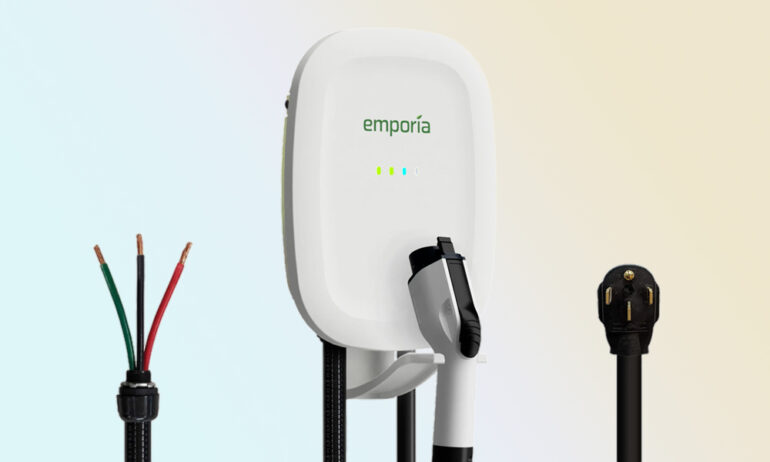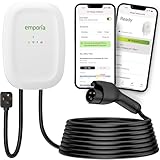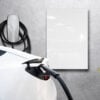When it comes to installing a wall-mounted EV charger in your home, there are only two real options: hardwired or plug-in. Both of these options allow you to fully charge an EV overnight, but there are some major differences when it comes to power, safety, installation, cost, and more. Here’s the difference between hardwired vs plug-in EV chargers, so you can make the right decision before installing a charger at home.
What Is a Hardwired EV Charger?
A hardwired EV charger connects directly to a dedicated circuit breaker in your electric panel. You’ll need an electrician to install a hardwired charger, which could cost more, but hardwired chargers are also safer, more reliable, and more powerful than plug-in chargers.
What Is a Plug-In EV Charger?
If you already have a 240-volt outlet in your garage, you can plug an EV charger in without installing anything. While plug-in chargers don’t supply as much power as hardwired chargers, they do offer greater flexibility if you ever want to upgrade your charger or take it with you when you move.
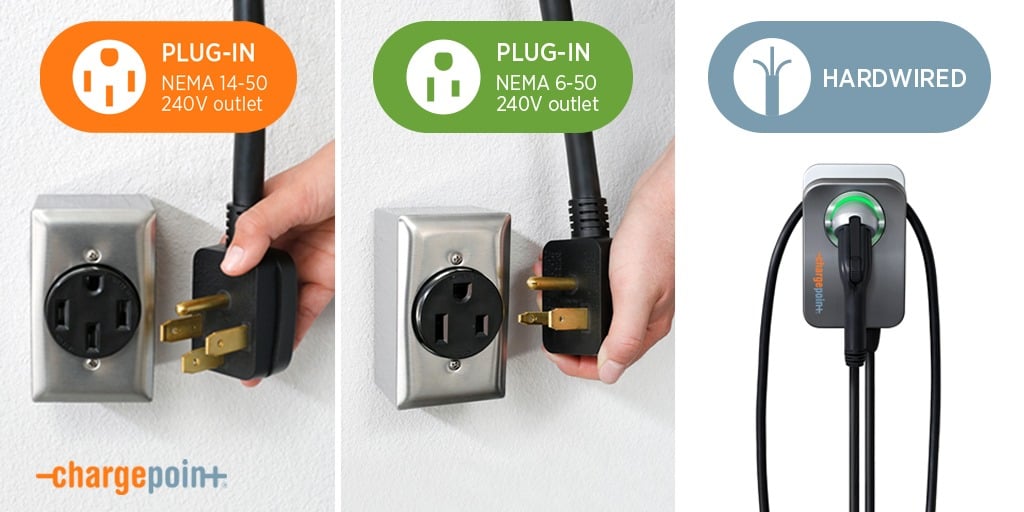
Hardwired vs Plug-In: Power
Hardwired chargers are capable of delivering up to 19.2 kilowatts (kW) of power, while plug-in chargers can only reach 9.6kW. However, most EVs only charge at 7.7-11.5kW, so you might not experience any difference between a hardwired charger or a plug-in model, depending on your car’s on-board charger.
Note: You might see EV chargers that list their power output in amps instead of kilowatts. In that case, you can calculate the kilowatt output by multiplying the charger’s amps by its volts. Since level 2 EV chargers carry 240 volts, a 40-amp model can output 9,600 watts (or 9.6 kilowatts).

What Is an EV On-Board Charger?
Before choosing an EV charger, it’s important to check the power rating of your car’s on-board charger. All electric cars have an on-board charger that takes the “alternating current” (AC) found in residential homes and converts it into “direct current” (DC) that your batteries need to charge.
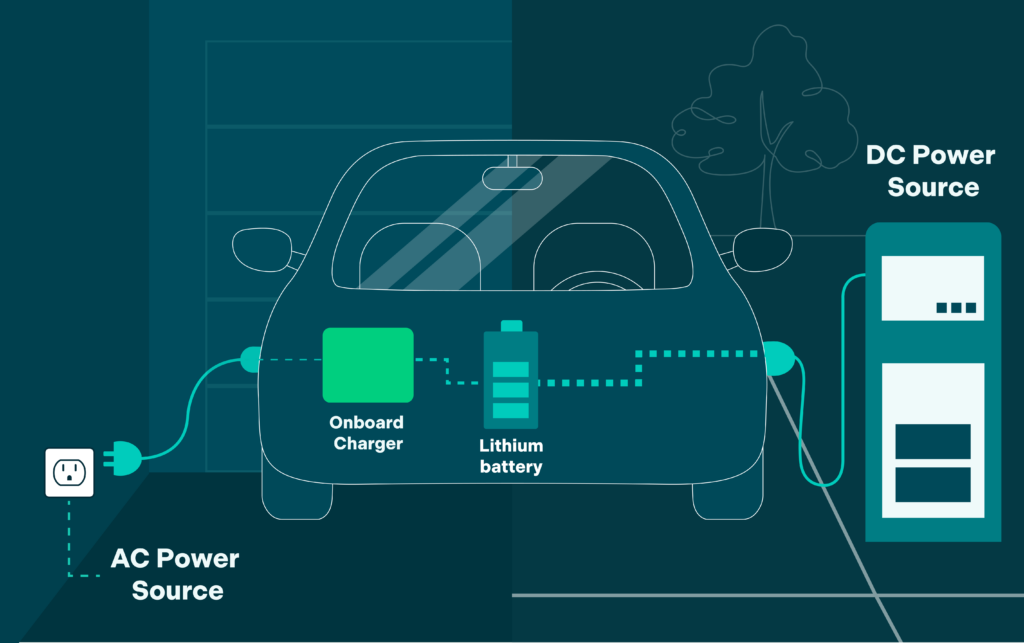
The power rating of your on-board charger ultimately determines the maximum amount of power your EV can accept. For example, most Teslas can accept up to 11.5kW. So, you’ll get the fastest charging speeds when you use a hardwired charger – because it is capable of outputting 11.5kW (at 48 amps).
Hardwired vs Plug-In: EV Charging Time
While a hardwired charger will be faster, it could only take an hour or two longer to fill an electric car from 0-100% using a plug-in charger. For example, hardwired chargers can add 44 miles of range to a Telsa model Y per hour, and a plug-in charger can add 37 miles of range.
If you charge your EV overnight, you might not experience any difference between a hardwired charger and a plug-in model. However, charging times can vary depending on your home’s electrical system, the temperature, your electric car’s efficiency, the size of your batteries, and many other factors.
Read More: How long does it take to charge an electric car?
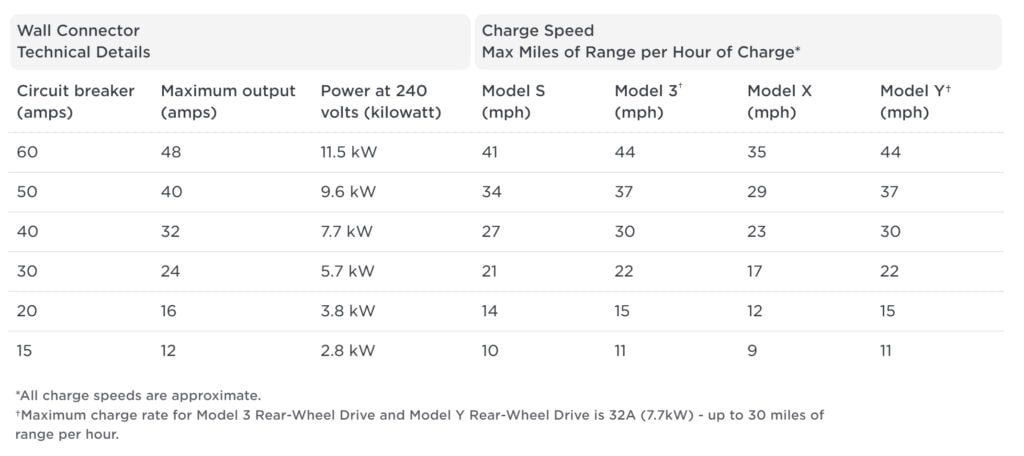
Which NEMA Outlet Should You Use?
For the fastest charging times, you’ll want to connect an EV charger to a NEMA 14-50 or NEMA 6-50 outlet. They are both capable of outputting 9.6kW of power (at 40 amps). Otherwise, plug your charger into a NEMA 14-30 or NEMA 10-30 outlet, both of which can output 5.8kW (at 24 amps).
Most plug-in EV chargers and mobile connectors are only made to work with one type of NEMA outlet. These outlets are larger than standard NEMA 5-15 outlets, and they are typically used for dryers, RVs, welders, air-conditioners, and other power-hungry devices.
Read More: Level 1 vs level 2 EV chargers
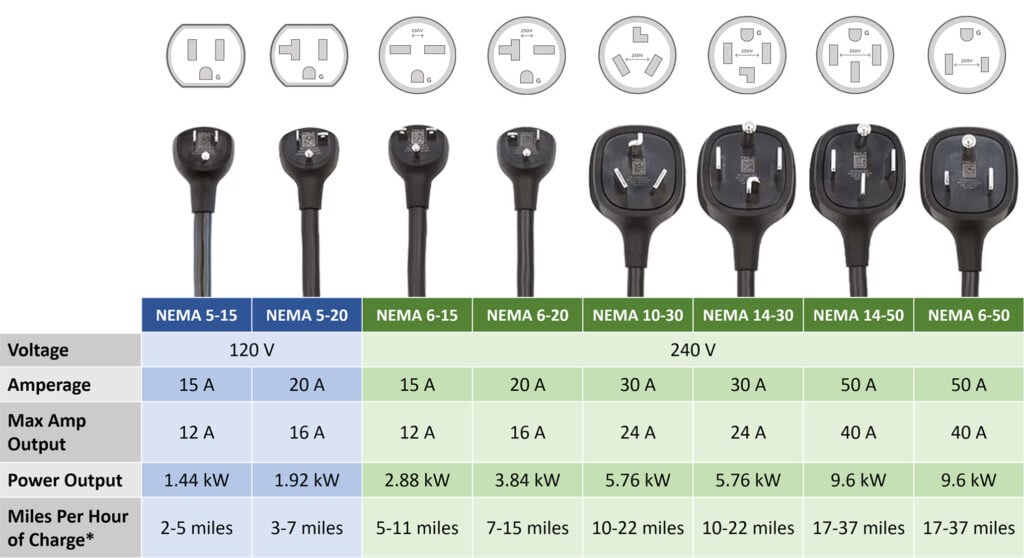
On the other end of the spectrum, it can take over three full days to fully charge an EV using a NEMA 5-15 outlet. That being said, if you leave your EV plugged in for 10 hours every night, you’ll get 20-50 miles of range with a NEMA 5-15 connector, which is around how much the average American drives, according to Kelly Blue Book.
It is important to note that using a 120-volt outlet causes around 15-20% energy loss, and they are even slower in cold weather. Plus, a mobile connector won’t let you set your charging speeds or create charging schedules on your smartphone, so you can save a lot more money with a hardwired charger.
Read More: How much does it cost to charge an EV?
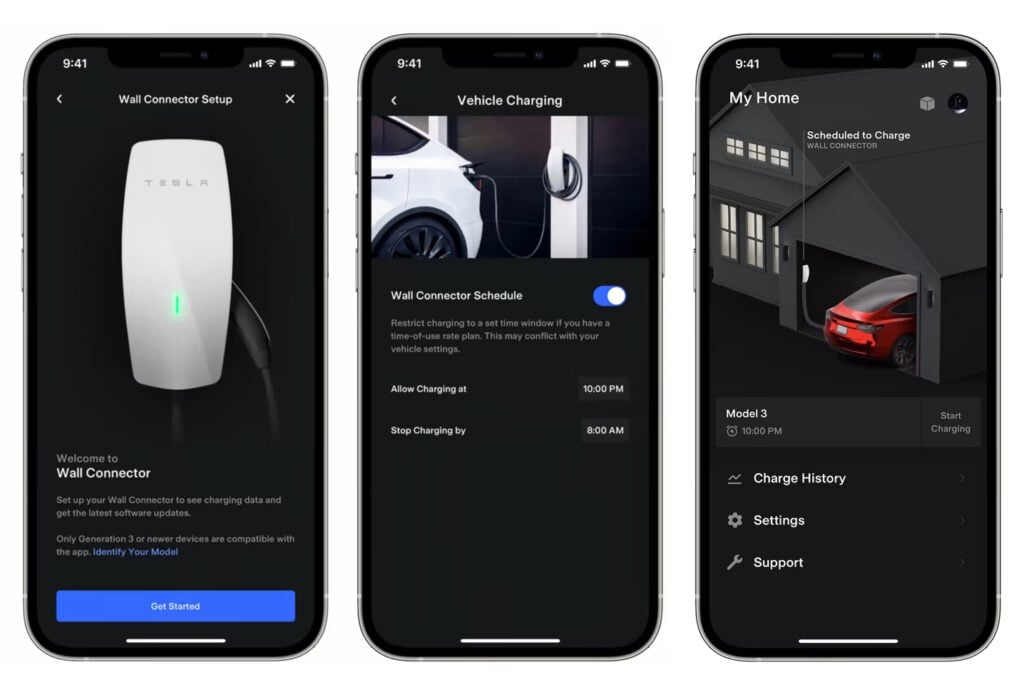
Remember the 80% Rule
According to the US National Electric Code, EV chargers require a “continuous load,” which means they are only allowed to use 80% of the circuit they are attached to. This is true whether you choose to hardwire an EV charger or plug it into a 240-volt outlet.
For example, if you hardwire an EV charger to a 60-amp circuit breaker in your electric panel, it will only be able to output 48 amps. On the other hand, the highest-rated NEMA outlets are rated for 50 amps, which means a plug-in charger can only output a maximum of 40 amps.
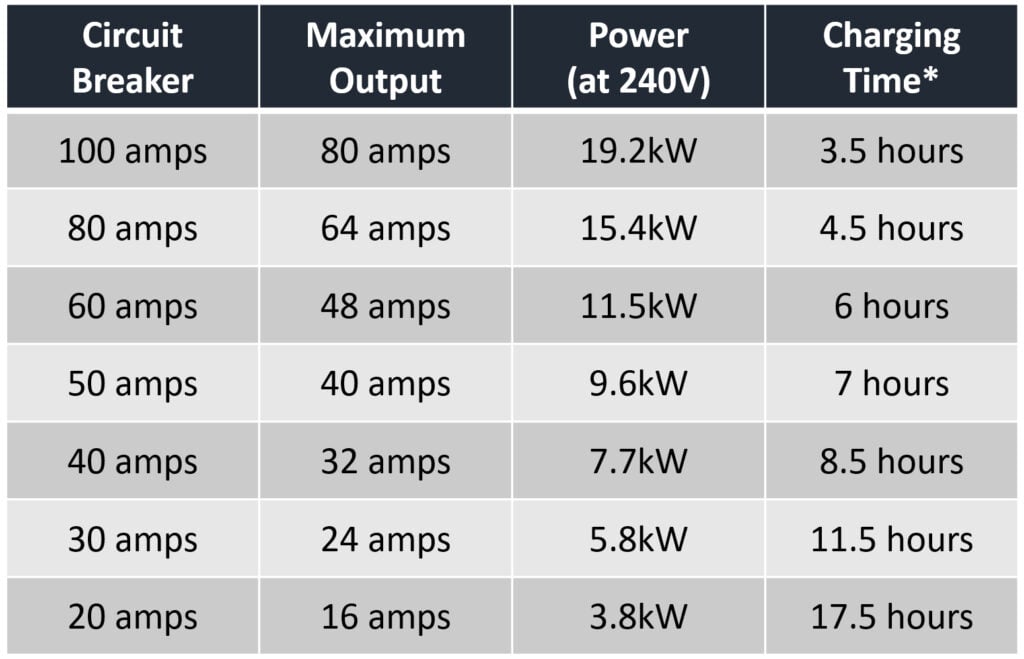
Most homes built after 1970 will have a 100-amp electric panel. This should leave enough room for a 60-amp EV charger. If your home only has a 60-amp charger, you might not be able to install an EV charger without upgrading your electric panel, which can be expensive
You should always contact an electrician to do a load calculation before installing an EV charger. Even if you only plan to plug your EV charger into an existing 240-volt outlet, you need to make sure you won’t overload your system, especially if you have lots of power-hungry devices and appliances in your home.
Hardwired vs Plug-In: Safety
Since a hardwired charger is connected directly to your electric panel, it uses fewer cables and outlets, which reduces the risk of overloading and tripping your electrical breakers. Hardwired chargers also come with GFCI (ground fault circuit interruption) protection, which further protects against shorts and surges.
Plug-in chargers require an additional connection, which means there’s more chance that the cables could get worn or frayed. Frayed wires have a greater chance of causing electric shocks and fires. Plus, plug-in chargers have a greater chance of “nuisance tripping.”
What Is Nuisance Tripping?
Most EV chargers these days come with GFCI protection built-in to help prevent your system overloading. However, US electric code now requires GFCI protection for all 240-volt outlets. Having two different breakers on the same circuit can lead to “nuisance tripping,” which can cause your power to go out regularly.
To avoid nuisance tripping, many EV manufacturers recommend using a NEMA outlet that does not have GFCI protection, but this might mean your home won’t pass an inspection, depending on where you live. So, if you want to future-proof your home, it’s a good idea to install a hardwired charger over a plug-in model.

Hardwired vs Plug-In: Convenience
One of the biggest advantages of installing a plug-in charger or a new 240-volt plug is that it allows you to upgrade at a later date. If a better charger comes out in the future, or your current charger just gets old or breaks, you can easily unplug it and swap it out with a charger.
With a hardwired charger, you’ll be stuck with the model you choose, or you’ll need to uninstall the old one and reinstall a new one whenever you want to upgrade.
Read More: How to choose the right EV charger
Hardwired vs Plug-In: Cost
If you already have a compatible 240-volt outlet in your garage, all you need to do is buy a plug-in charger and mount it on the wall. On the other hand, you’ll need a professional electrician to install a hardwired charger for you, which usually costs $1,000 or more, not including the price of the EV charger itself.
The cost of installing a hardwired charger often comes down to how far your garage or parking space is from an electric panel in your home. The farther away your electric panel is, the more it will cost to install an EV charger. However, if your electric panel is only rated for 60-amps or less, the cost of upgrading your electric system can cost thousands of dollars.
Installing a hardwired EV charger also requires you to obtain certain permits, which can cost a few hundred dollars, depending on where you live. On the other hand, you might be able to take advantage of rebates in your city or state to save money on the cost of installation. Check with your local power company to find out the rebates and programs you might be eligible for.
Read More: The best EV chargers to install in your home
If you need any help installing an EV charger in your home, HelloTech can send an electrician to your door to give you a free quote. We can provide an in-home quote in as little as 15-30 minutes, and our technicians can schedule your installation within a week or two of the estimate.
